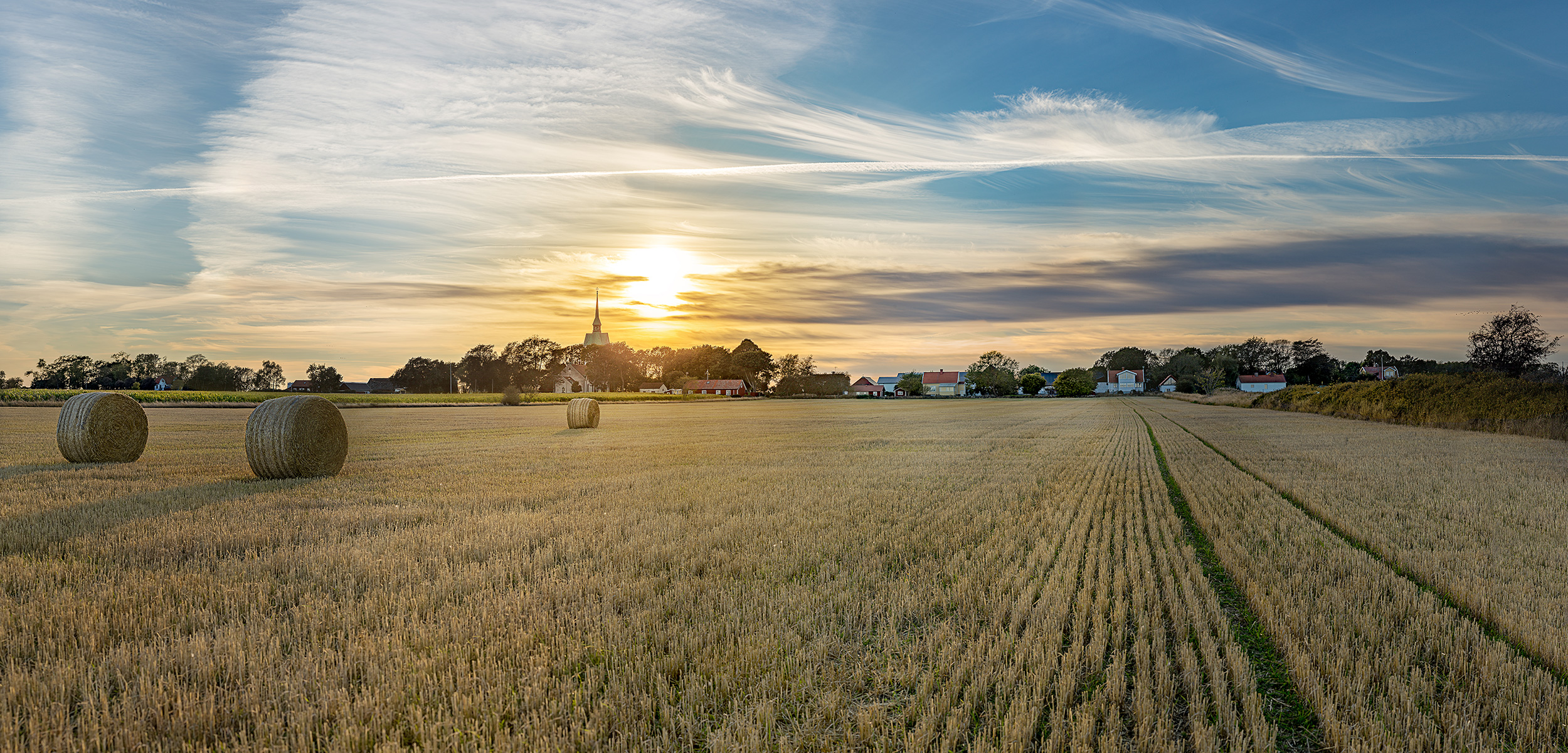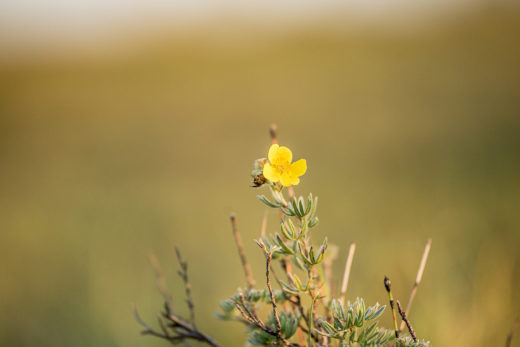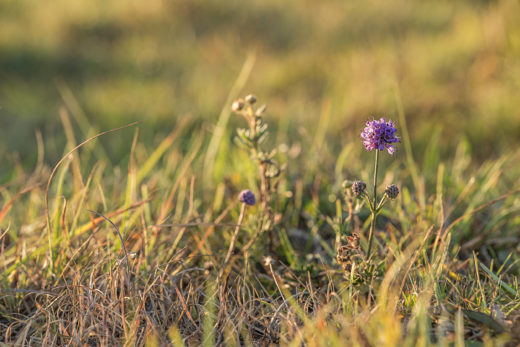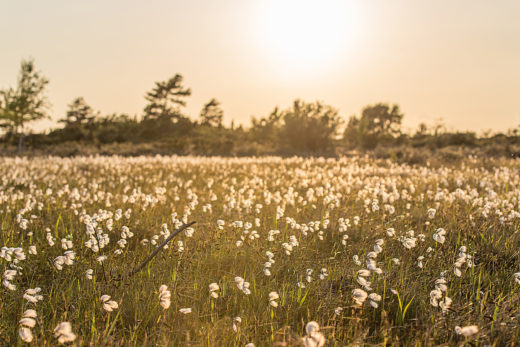A Swedish Island’s Rare Balancing Act
On Öland, humans and grazing cattle have created a haven of biodiversity and preserved it for thousands of years.
Article body copy
What I notice first about the island of Öland is the wind. Blowing in hard off the Baltic Sea, it whips the island’s grasses and trees and stretches taut the blue and yellow Swedish flags hanging from front-yard flagpoles. It tears and rips at my notebook and turns a sunny day in early June into a wintry struggle to stay warm. Sometimes the gusts are so strong here that the six-kilometer bridge to the town of Kalmar on the Swedish mainland has to close for safety, temporarily isolating the island.
The second thing I notice about the southern half of Öland is how unspectacular it is for a place that’s been listed as a UNESCO World Heritage Site since 2000. The island’s characteristic feature is something called alvar, a plain of scrubby grass punctuated by patches of bare limestone and gravel, with topsoil so thin in most places I can reach bedrock with a scrape of my boot heel.
Alvar is an extremely rare environment that exists in just a few places in the world, including a few other spots around the Baltic. It’s windswept, of course, and mostly empty, except for the odd cluster of cattle and long, low, lichen-covered stone walls. Despite its UNESCO status, southern Öland doesn’t even have a visitor’s center, just a few faded roadside signs.
The third thing I notice is just how passionate locals are about the place. Everyone agrees its beauty eludes the camera and can’t quite be explained to outsiders. But the islanders I meet rhapsodize about the yellow, brown, and green colors of the alvar, or the way the clouds hang low and gray on a November morning.
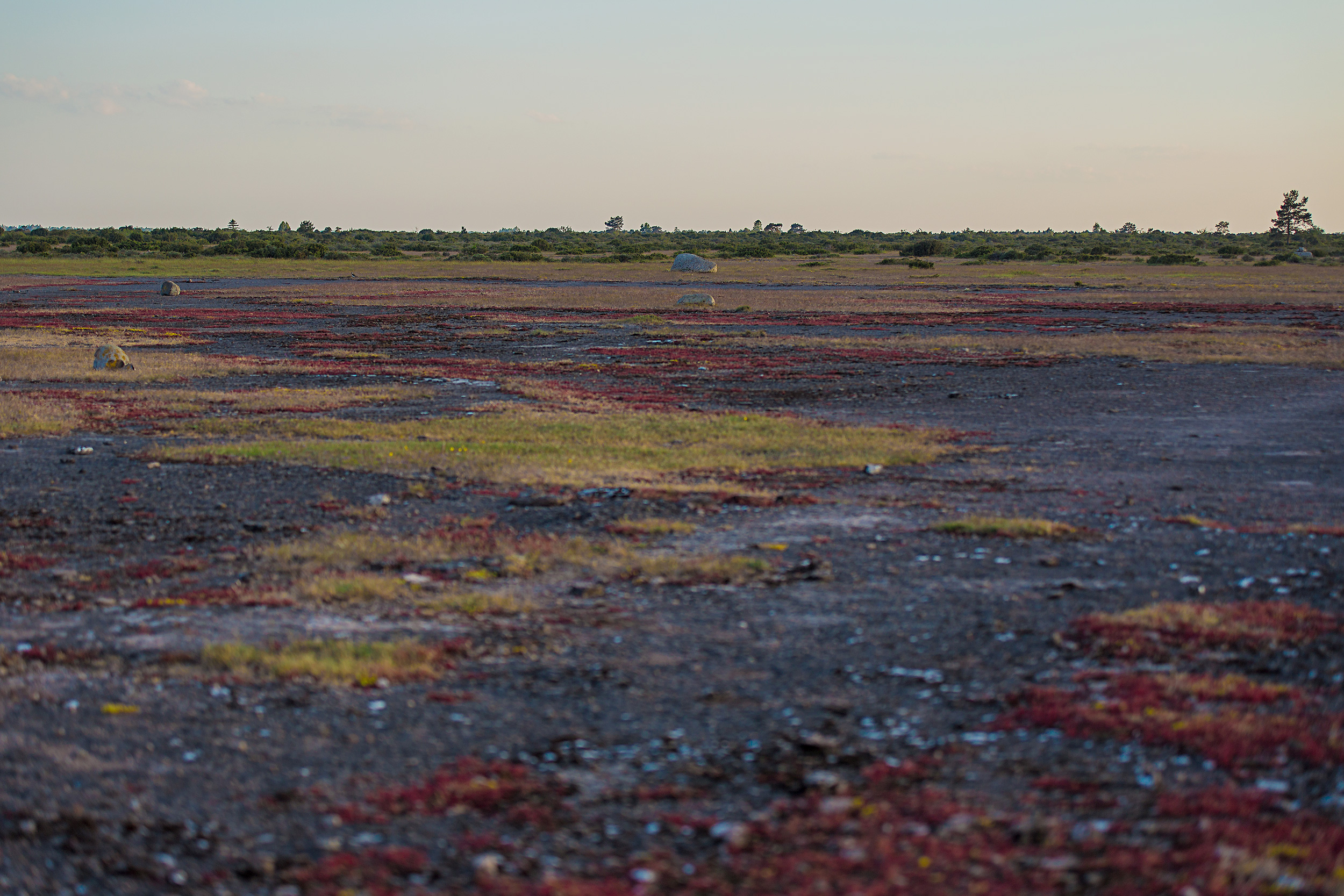
Treeless and bleak looking at first glance, the island’s rare alvar environment is a botanist’s delight, with nearly 35 species of orchids alone. Photo by Jörgen Tannerstedt
People have lived on Öland for some 6,000 years, farming on the island for 5,000 years or more. Evidence suggests that Öland today looks a lot like it did during the Iron Age, which ended nearly 1,000 years ago. Most of its villages and farm fields have been in the same place since the Middle Ages. This consistent, harmonious relationship between humans, cattle, and the natural world has helped to create a place of surprising biodiversity. Nearly 35 species of orchids alone flourish on Öland.
Marie-José Gaillard may not be a native-born Ölander, but she is a big fan of the alvar. She’s a transplant, a Swiss-born paleoecologist with a lilting French accent who has lived in Sweden since she came north as a postdoc in 1981. She has a keen eye for Öland’s hundreds of under-appreciated plant species and an encyclopedic knowledge of their names in four languages.
I meet Gaillard at a general store painted a crisp white near the town of Mörbylånga. After a cinnamon bun and a strong coffee, we hop in her black Peugeot and drive south along the coast before turning onto one of the narrow roads that cut across the middle of the island. To either side, green and brown plains stretch to the horizon, broken only occasionally by clumps of juniper and clusters of grazing cattle.
After a few kilometers, Gaillard pulls over and parks. We clamber over a low stone wall onto the alvar. Almost immediately, Gaillard is on her knees, eagerly pointing out the plants at our feet.
There’s Potentilla fruticosa, whose mustard-yellow flowers—barely high enough to reach my bootlaces—are spotted more often in Siberia. Nearby, ankle-high orchids with delicate, drooping purple flowers that Swedes call “St. Peter’s Keys” nod in the wind. Gaillard fingers a spray of Helianthemum oelandicum, a yellow flower native to the island, before rising to hike further.
The diversity at our feet surprises me, given the adversity the plants face. The soil on the alvar plain is rarely more than a few centimeters deep, spread thinly across the porous plateau like butter on toast. The plateau also has a slight slope down to the coast, subjecting what little soil there is to constant erosion.
Southern Öland is one of the driest spots in Sweden, with only 450 millimeters of annual precipitation. And when it does rain, conditions can change from a modest flood to drought-like in just a few days, as water drains quickly into the alvar’s permeable limestone bedrock. “In the autumn or spring, you even see small ponds and flowing rivers,” Gaillard says. “And then, pfft—it’s all gone.” Throw in the wind and nutrient-poor soil, and it seems remarkable plants survive here at all.
Yet Öland’s flora and fauna are surprisingly diverse. Seventy percent of Sweden’s insect species can be found on the island, along with several unique butterflies. A dozen of the plant species are found nowhere else in the world, and the island is a major destination for birdwatchers, who come to see rarities like marsh sandpipers and rose-colored starlings. The alvar creates a rich environment, though it can take an expert eye to see just how biologically affluent it is.
As we make our way from flower to flower, Gaillard tells me she likes to take her botany classes on walks just like this. Laying down her jacket at random, she challenges them to identify the plant species that lie underneath or around it. “Often, we can find 20 to 30 species in a single square meter,” she says.
The plants on the alvar are exquisitely evolved to fit into very narrow niches. Some are species typically found high in the windswept Alps, while others are seen on the cold Siberian steppes. It’s a surprise to find them together on a Baltic island, mixing companionably with other species to create a unique ecosystem. Öland’s tough environment favors highly specialized species that can’t compete in wider ecological niches: the plants here would probably be elbowed out in an area with richer soil, for example.
Until fairly recently, naturalists and conservationists thought the singular environment of the alvar was a naturally occurring product of geology and weather, a story in which people played little or no role.
Recent research is telling a very different story. Based on pollen samples taken from ponds on the alvar in the 1960s, Gaillard and others have been able to reconstruct the island’s paleoecology, creating a picture of the island’s flora that stretches back 11,000 years.
The pollen counts suggest that people have played a crucial role in preserving, and even promoting, the alvar’s biodiversity for millennia. That’s key to the island’s modern identity, and its status as a World Heritage Site. “Southern Öland takes its contemporary form from its long cultural history, adapting to the physical constraints of the geology and topography,” the UNESCO description reads.
“If you ask me, this is a human, cultural landscape,” Gaillard says, nodding at the flowers at our feet. “It’s human impact that has made the alvar so open and large. Without humans, it would look totally different.”
To understand how this relationship works, I get up early the next morning and drive to the village of Gräsgård, near Öland’s southern end, to meet dairy farmer Roger Gustafsson. The drive takes me almost an hour: Öland is big, 137 kilometers long and 16 kilometers across at its widest point. Its 1,344 square kilometers make it almost as large as Hawaii’s Kauai and spacious enough to accommodate 22 Manhattans.
Yet only 25,000 people live on Öland year-round, together with 40,000 cows and sheep. (Manhattan crams in 1.6 million.) The northern end of the island is covered in thick forest and is popular with tourists from Sweden and Germany. The southern end is mostly open, windswept alvar, with farm fields and pasture squeezed in along the coast.
Gräsgård, it turns out, is so small that the GPS I rented in Copenhagen can’t find it. I end up on the wrong side of the island, half an hour late for my meeting with Gustafsson. When I finally show up, the stocky, black-haired dairy farmer is waiting for me in front of his milking barn, next door to the village church.
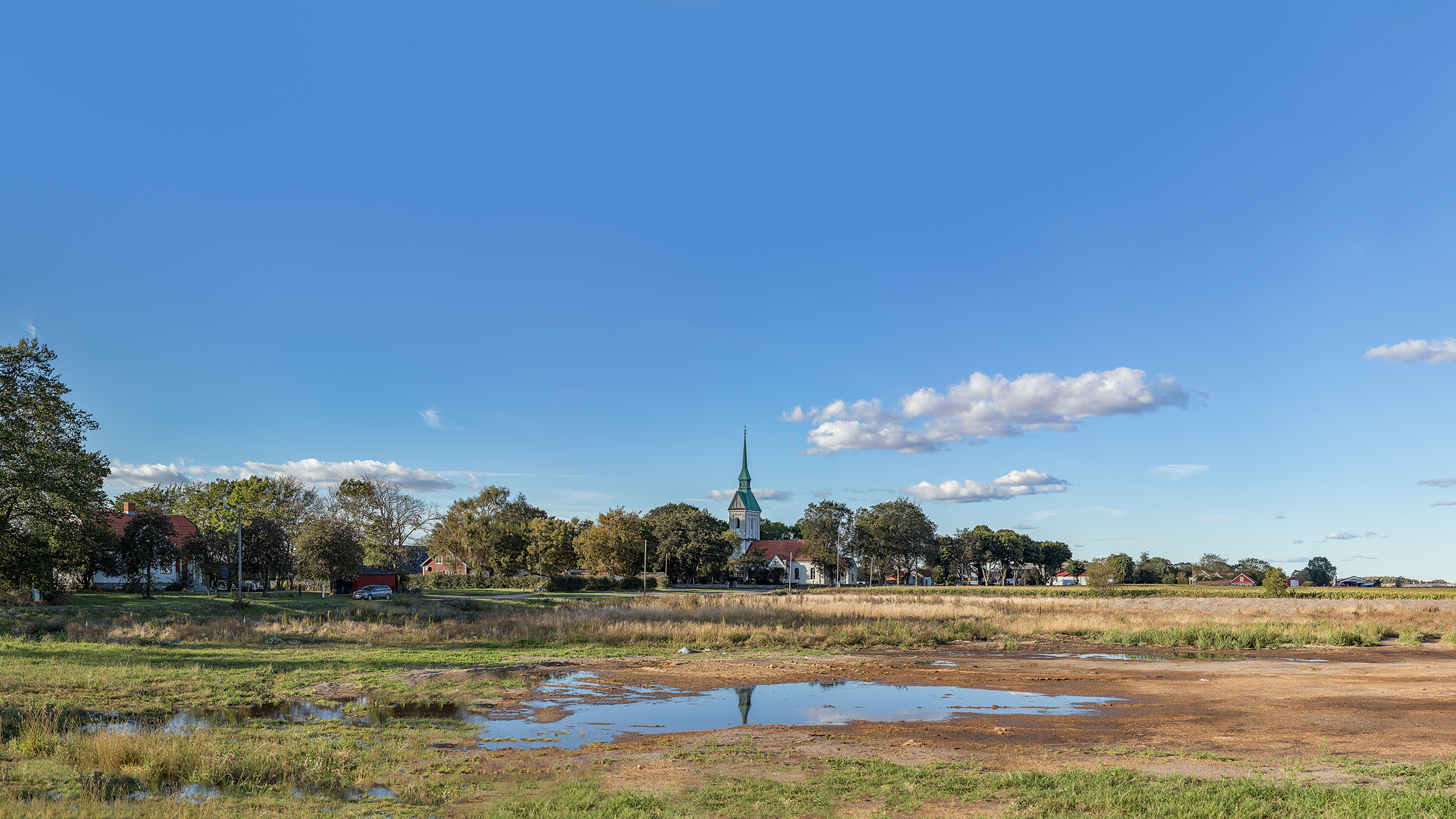
The layout of small villages like Gräsgård (shown above) hasn’t changed much in the past 800 years, with houses strung in rows along a single road and fields immediately behind each. Photo by Jörgen Tannerstedt
Gustafsson has thick, strong hands and a ready smile. The 47-year-old farmer defies the stereotype of Scandinavians as quiet and reserved: within minutes, he’s telling me his life story, pointing out the blue house he grew up in just on the other side of the church. At age 20, he moved up the road 300 meters, when he bought a farm within sight of his parents’ house. He’s since grown the modest farm into a modern 220-cow dairy that uses robotic milking machines, other innovations, and a handful of workers to produce two million liters of milk per year for one of Sweden’s big milk co-ops.
Each spring, Gustafsson turns his calves and heifers, which produce no milk, out onto the alvar behind Gräsgård, where they spend much of the summer grazing on the patchy grass and munching newly-sprouted juniper bushes. By trimming back small trees and juniper, cattle keep the alvar open, says Gustafsson, and their grazing makes room for fragile plants to flourish on the forbidding limestone plateau, while the cattle dung enriches the thin soil. Gustafsson, or his in-laws, check on the cattle daily—not because they’re liable to wander off their patch of the alvar, but because it reassures them. “It’s best to be a partner” with them, he says. “Visiting them keeps them calm.”
The ritual of turning them onto the alvar likely dates back to the first cattle herders who landed here 6,000 years ago. Dairy farmers “are very needed to have the Öland we have today,” Gustafsson says. “Without our work, it wouldn’t be so beautiful. There would be nothing to see. If we’re not having bulls and heifers out on the alvar, it would all grow over.”

Öland farmer Roger Gustafsson stands in front of his modern dairy, which produces two million liters of milk a year. Photo by Jörgen Tannerstedt
It’s a conviction that flies in the face of how most people see the relationship between humans and nature. Swedish naturalist Carl Linnaeus, who invented the taxonomic naming system we still use to classify plants and animals, visited the island briefly in the mid-18th century. At the time, Linnaeus wondered if Öland’s landscape was the sad result of overgrazing. “Walls or rudiments of fences, which were signs of large enclosed places on the Alvar, caused us to conclude that this barren Alvar had formerly been more fruitful and thus more cultivated, divided and enclosed,” Linnaeus wrote in a 1745 report.
More than 200 years later, a Swedish paleobotanist named Lars-Konig Konigsson took pollen samples from bogs and ponds across a swath of Öland’s alvar to see whether the island’s unusual, productive environment is actually a direct result of human presence. Recently, Gaillard, working with a team of geologists, archaeologists, and historians, has used Konigsson’s notes and pollen counts to develop a more detailed history of the alvar.
This new picture suggests that people were cutting down Öland’s trees and clearing land on the island as early as 6,000 years ago: that’s when the amount of pollen from grass and herb species began climbing in proportion to trees and also when the first cattle herders arrived. Deforestation accelerated 2,000 years later, when the island’s population began to grow. As human activity on the island increased, the amount of pollen from trees in the samples dropped again while the amount from grassland species spiked. Far from devastating the environment, human activity seems to have transformed it into the remarkably biodiverse place it is today.
More evidence came via an unintentional late 20th-century experiment. In the 1970s, government policy, informed by the prevailing conservation thinking at the time, tried to preserve the alvar by shooing the island’s cattle and sheep off the plain and back to their barns and seaside pastures. By the time Gaillard arrived on the island to take up a teaching position at Linnaeus University in the early 1990s, dark green stands of tough juniper clotted the plateau, taking over areas where orchids once bloomed and threatening the island’s delicate balance. “Conservation politics didn’t understand human impact could be good,” says Gaillard.

Cattle that graze on the alvar (above) keep dark green clumps of juniper from taking over the areas where orchids and other rare plants blossom. Photo by Jörgen Tannerstedt
Beginning in the late 1980s, though, a handful of ecologists persuaded Swedish politicians to take another look at the impact of cattle on the grasslands. When Sweden joined the European Union in 1995, agricultural subsidies encouraged farmers to graze their cattle on the alvar and restore its biological diversity—reversing the “hands-off” policies of the 1970s. Gustafsson says just a few decades without cattle had reduced the area of alvar dramatically. “We had to burn and cut the bushes to restore the grassland,” he recalls. “That showed us if we don’t have animals out on the grassland, it would be totally bushy.”
This delicate interaction between humans and nature has been at play for longer than anyone here can remember. Standing on the concrete apron of his dairy barn, the smell of hay and cow mixing with the sea breeze, I ask Gustafsson how long his family has lived on Öland. The question seems to confuse him. I start to repeat it, and then catch myself. I realize he can’t think of a time when his family wasn’t on the island.
Just driving along the coast is a trip back through time. Bronze Age burial mounds and standing stones from the Iron Age still line the roads. In tidy village churchyards, Christian tombstones mingle with Viking-era rune stones. Lichen-covered stone walls—so worn that they looked old to Linnaeus when he visited in 1741—define the property lines and stretch from farmyards straight onto the scrubby alvar.
Gräsgård, where Gustafsson has lived for 46 of his 47 years, is a perfect example of a village that seems to have escaped the passage of time. It’s tiny, a dozen or so houses, arranged on either side of a church. Across the road, fields of grass ripple in the wind blowing from the Baltic Sea, 300 meters away.
Just as humans have shaped Öland’s environment, the island’s topographical constraints have shaped how and where people here live. The windy, nearly treeless alvar is inhospitable and because of the slight slope of the plain, topsoil washes off it and builds up enough to support crops in just a few spots on the island, mostly along the coast. That means Öland’s villages are strung like beads on a necklace along the coast road that rings the alvar plain.
Like most of Öland’s towns, Gräsgård’s layout hasn’t changed much in 800 years or more. It’s typical of towns on the island, which are arranged in long rows along a single road and known as “radby,” or row villages. Each farmhouse typically owns the fields immediately behind it, and the village as a whole collectively manages the adjacent alvar, some coming together over a meal not long after New Year’s Day to decide how many cattle each person can graze on the community’s land in the year to come.
In the Middle Ages, most of Europe was organized like Gräsgård: small, dense clusters of houses surrounded by little fenced-off fields, with cattle and sheep pastures a short hike away and forest beyond. In the 19th century, land reformers in Sweden and many other parts of Europe consolidated properties to make farming more efficient. They reasoned it would be better to plow and plant one 20-acre spread than 20 one-acre spreads. But in their quest for efficiency, they broke up tight-knit villages in favor of solitary farms, often scattered kilometers apart, with each house at the center of its own sprawling constellation of fields.
On Öland, the limited amount of arable land left literally no room for land reform. Islander contrarianism also contributed to resistance to the changes, Gaillard suspects, but so did millennia of learning to thrive in a constrained environment. “They had good arguments, and geology was on their side,” Gaillard says. As a result, “villages, fields, and grazing lands are still in the same place as they were in the early Iron Age.”
Those centuries of stability and harmony between people and nature earned southern Öland its spot on UNESCO’s World Heritage Site list, recognized as “an outstanding example of human settlement.” “It’s a living site, a living landscape,” says Cornelius Holtorf, a professor at Linnaeus University who studies cultural heritage issues. “It’s all about continuity.”
But inevitably, the island is changing. A few years ago, Öland’s first wind turbines were installed within the World Heritage Site’s boundaries, sparking controversy over whether they were in keeping with the island’s heritage. And as agriculture becomes more efficient and globalized, the pressures on farmers here are growing. Fifteen dairy farmers once lived in Gräsgård; now there are just three. “The number of cows is the same, but the number of farmers is going down,” Gustafsson says.

“Dairy farmers are very needed to have the Öland we have today,” says Roger Gustafsson. Without them and their cattle, the alvar would be overcome by tough juniper bushes. Photo by Jörgen Tannerstedt
So are milk prices, which have sunk to their lowest levels in years. Government subsidies have kept farms afloat in the past, but Gustafsson worries that if the few dairy and beef farmers left on the island go bankrupt, there won’t be anyone to herd cattle on and off the alvar. And that would be a big loss. “We, as farmers, are the heritage, in a way,” he says.
Later that day, I decide to explore the alvar alone. I pull off the road at random, making a left just past a sturdy-looking church in the village of Vickleby. A stone wall, whose top is festooned with white lichen, runs from the edge of a small parking lot straight to the horizon. The wall is my guide as I walk beside it, eyes trained on the ground.
Without a botanist by my side, I’m at a loss. At first all I notice are cow patties and horse dung and some hiker’s lost glove, hanging from a dead juniper bush. Then I bend down and see some lovely flowers with tiny, pale violet blooms, plus purple puffballs I don’t recognize. I almost step on the creeping yellow flowers Gaillard pointed out on our walk, their thirsty roots poised to suck up every drop of the light rain that’s pattering down on my jacket and spotting my notebook. Nearby, the soil gives way entirely to patches of small rocks and bare limestone.
I thread my way through a stand of juniper and lose sight of the church. In the distance, I can hear an industrial mower droning, cutting the first hay of the year. As the rain stops and the wind picks up, I turn to go. Walking back, I’m moved by the thought that I don’t have to feel out of place here, or worry about whether my footsteps are disturbing some delicate balance. In a world brimming with tales of environmental destruction, it’s comforting to think that people here found a way to get by without going overboard—and along the way played a big part in creating something special.

